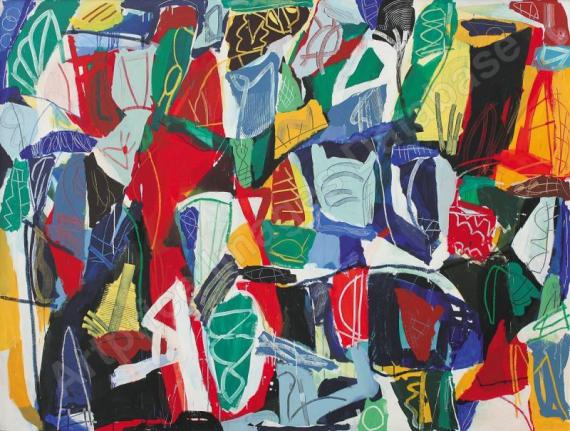Frame image
243
Jan Voss
Ohne Titel, 1993.
Mixed media on canvas on wood
Post auction sale: € 18,000 / $ 21,240
Ohne Titel. 1993.
Mixed media on canvas on wood.
Signed and dated in the lower right. 195 x 280 cm (76.7 x 110.2 in). [AW].
• A work in large format and rich colors that intrigues with its dynamism and diversity.
• Complex works such as this one, made from a wide variety of materials, techniques, colors, and shapes, are typical of Voss' oeuvre.
• In 1968, he participated in documenta 4 in Kassel.
• Works by Jan Voss can be found in, among others, the Centre Pompidou in Paris, the Moderna Museet in Stockholm, and the Sprengel Museum in Hanover.
PROVENANCE: Private collection Hesse.
Mixed media on canvas on wood.
Signed and dated in the lower right. 195 x 280 cm (76.7 x 110.2 in). [AW].
• A work in large format and rich colors that intrigues with its dynamism and diversity.
• Complex works such as this one, made from a wide variety of materials, techniques, colors, and shapes, are typical of Voss' oeuvre.
• In 1968, he participated in documenta 4 in Kassel.
• Works by Jan Voss can be found in, among others, the Centre Pompidou in Paris, the Moderna Museet in Stockholm, and the Sprengel Museum in Hanover.
PROVENANCE: Private collection Hesse.
243
Jan Voss
Ohne Titel, 1993.
Mixed media on canvas on wood
Post auction sale: € 18,000 / $ 21,240
Buyer's premium, taxation and resale right compensation for Jan Voss "Ohne Titel"
This lot can only be purchased subject to regular taxation, artist‘s resale right compensation is due.
Regular taxation:
Hammer price up to 800,000 €: herefrom 27 % premium.
The share of the hammer price exceeding 800,000 € is subject to a premium of 21% and is added to the premium of the share of the hammer price up to 800,000 €.
The share of the hammer price exceeding 4,000,000 € is subject to a premium of 15% and is added to the premium of the share of the hammer price up to 4,000,000 €.
The statutory VAT of currently 7 % is levied to the sum of hammer price and premium.
Calculation of artist‘s resale right compensation:
For works by living artists, or by artists who died less than 70 years ago, a artist‘s resale right compensation is levied in accordance with Section 26 UrhG:
4 % of hammer price from 400.00 euros up to 50,000 euros,
another 3 % of the hammer price from 50,000.01 to 200,000 euros,
another 1 % for the part of the sales proceeds from 200,000.01 to 350,000 euros,
another 0.5 % for the part of the sale proceeds from 350,000.01 to 500,000 euros and
another 0.25 % of the hammer price over 500,000 euros.
The maximum total of the resale right fee is EUR 12,500.
The artist‘s resale right compensation is VAT-exempt.
Regular taxation:
Hammer price up to 800,000 €: herefrom 27 % premium.
The share of the hammer price exceeding 800,000 € is subject to a premium of 21% and is added to the premium of the share of the hammer price up to 800,000 €.
The share of the hammer price exceeding 4,000,000 € is subject to a premium of 15% and is added to the premium of the share of the hammer price up to 4,000,000 €.
The statutory VAT of currently 7 % is levied to the sum of hammer price and premium.
Calculation of artist‘s resale right compensation:
For works by living artists, or by artists who died less than 70 years ago, a artist‘s resale right compensation is levied in accordance with Section 26 UrhG:
4 % of hammer price from 400.00 euros up to 50,000 euros,
another 3 % of the hammer price from 50,000.01 to 200,000 euros,
another 1 % for the part of the sales proceeds from 200,000.01 to 350,000 euros,
another 0.5 % for the part of the sale proceeds from 350,000.01 to 500,000 euros and
another 0.25 % of the hammer price over 500,000 euros.
The maximum total of the resale right fee is EUR 12,500.
The artist‘s resale right compensation is VAT-exempt.
Headquarters
Joseph-Wild-Str. 18
81829 Munich
Phone: +49 89 55 244-0
Fax: +49 89 55 244-177
info@kettererkunst.de
Louisa von Saucken / Undine Schleifer
Holstenwall 5
20355 Hamburg
Phone: +49 40 37 49 61-0
Fax: +49 40 37 49 61-66
infohamburg@kettererkunst.de
Dr. Simone Wiechers / Nane Schlage
Fasanenstr. 70
10719 Berlin
Phone: +49 30 88 67 53-63
Fax: +49 30 88 67 56-43
infoberlin@kettererkunst.de
Cordula Lichtenberg
Gertrudenstraße 24-28
50667 Cologne
Phone: +49 221 510 908-15
infokoeln@kettererkunst.de
Hessen
Rhineland-Palatinate
Miriam Heß
Phone: +49 62 21 58 80-038
Fax: +49 62 21 58 80-595
infoheidelberg@kettererkunst.de
We will inform you in time.




 Lot 243
Lot 243 


